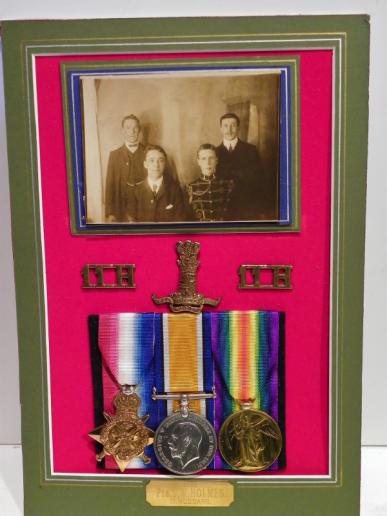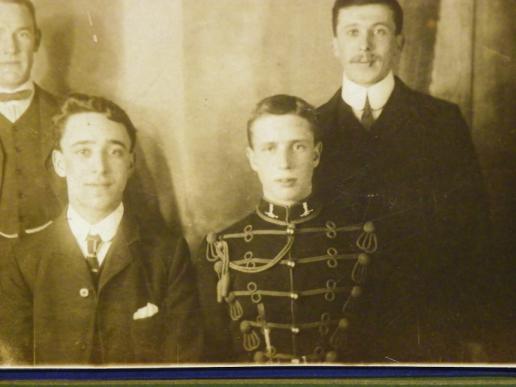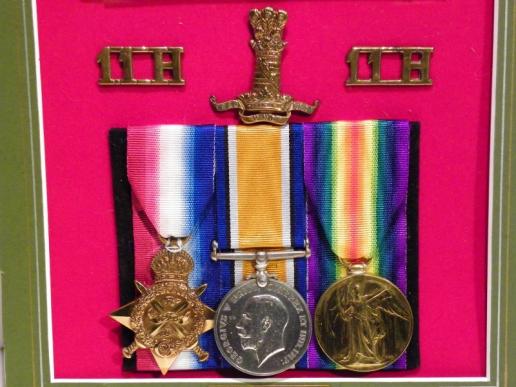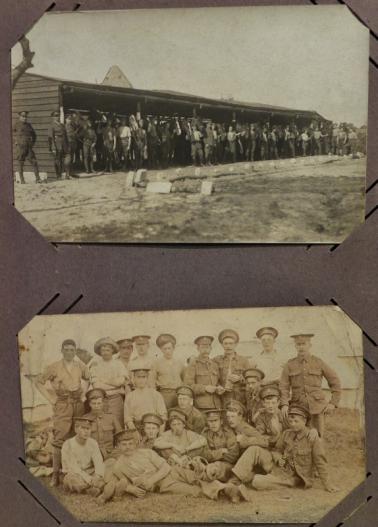Superb 1914 Star & Bar Trio & More to 11th Hussars - Mons & Charge at Nery.
Here is a magnificent group of medals and a whole load of personal items all belonging to 6032 Private Thomas W Holmes of the 11th Prince Alberts Own Hussars.
This lot comprises of; his 1914 star & Mons bar trio. The same ribbon bar, family photo/post card album, this contains WW1 photographs of Thomas and his cavalry troop in France, postcards sent home during the war, later his wife and family, many postcards sent to and from himself and his wife and children. His WW1 army issue diary, his spurs, WW1 issue document wallet. WW1 army Jack Knife, WW1 era Cigarette case with some original Cigarettes. 1914 Christmas tin and other bits and bobs which you can see in the pictures.
Thomas William Holmes was born in Great Yarmouth Norfolk around 1890, the third of Seven sons and one daughter of Johnathan and Rachel Holmes. Johnathan a Yarmouth Ships Chandler. His Brother 2nd Lieutenant Albert Holmes was KIA in September 1918 on the Somme. Please see my other listing.
Thomas first entered the theatre of war in France on the 15th August 1914 with the 11th Hussars, part of the 1st Cavalry Brigade of the 1st Cavalry Division. Thomas’s first engagement was at Mons and he took part in the Great Retreat. The Retreat from Mons is the name given to the long withdrawal to the River Marne, in August and September of 1914. The battle of Marne ended the British retreat 5th to 12th September, this forced the German armies to retire towards the Aisne river and fight the First Battle of the Aisne, 13th to 28th September 1914.
Thomas also took part in the famous cavalry charge which led to the capture of eight German guns at Néry in September 1914. The 11th were sent on patrol early in the morning, they spotted a column of Geman Ulans 150 yards away. One of the men fired on them unaware it was a main body of German cavalry, so 2nd Lieutenant Tailby ordered a charge. Surprisingly the Germans retreated but it had given the British position away. A German cavalry division of about twice their strength attacked shortly after dawn. The British artillery was mostly put out of action in the first few minutes, but a single gun of L Battery, Royal Horse Artillery, successfully kept up a steady fire for two and a half hours against a full battery of German artillery. The 11th Hussars endured a heavy German bombardment that left many of its soldiers buried in a trench, while another squadron from the regiment used a vantage point at the top of a building to train a machine gun on the advancing Germans. The 1st cavalry division suffered 81 casualty’s that day, the mounted 11th Hussars gave a cavalry charged with drawn swords, that helped to rout the German forces and capture the guns with what was left of the 2nd Dragoon Guards, but it would be very unjust of me not to mention; it was the efforts of L Battery, Royal Horse Artillery who really won the day. It lost over a quarter of its men and all five officers, of which three men won the VC for their actions. One of the guns still survives in the Imperial war museum; it carries the title of the ‘Nery Gun’.
From here Thomas would have gone on to an area near Ypres, between October 19th and 23rd 1914 the 11th fought successfully in the Ploegsteert area, helping to stop the advance of 3 German cavalry divisions. From here the regiment was dismounted, due to a lack of infantry, the British were gravely outnumbered by German forces, the Germans brought in 6 new divisions to make an all-out assault on the British line between Messines and Gheluvelt. Here they fought bravely and Sergeant T Frane won the DCM.
A period of rest and training followed and the regiment more or less stayed in the salient. At the Second Battle of Ypres in April 1915 the regiment, working with the Durham Light Infantry and 9th Lancers, held the village of Hooge despite being under attack from the German forces using poison gas. Later in March the 1st Cavalry Division were ordered to hold at all cost, the ground between the Somme and the Ancre. The fighting was so hard around Sailly Laurette that the 11th were pulled back across the Somme to hold the line at Hamel to block the German advance on Amiens. They took, what was said to be one of the heaviest German bombardments of the war, they took part in intense hand-to-hand fighting. This battle, lasting 2 weeks had cost the 11th three officers and 24 other ranks killed and 86 officers and men wounded.
At this point, I do not know what happened to Thomas, this needs further research. I think it is very unlikely he wasn’t wounded during his time in France, but as his medal index card shows he was renumbered, it is possible he stayed with the regiment throughout the entire conflict.
Most regiment history’s say that the cavalry did little from 1915 until the latter part of the war, when they were mounted and charged again against impossible odds; but the regimental diary’s say different. They took part in many different skirmishes and suffered very many casualties in their part.
Thomas survived the war and after married Carrie Lamb and had two children Tom and Lillian, Tom when on to serve in the Military Police, please see my other listing for Tom Juniors medals photographs and effects.
Carrie sadly out lived Thomas, Thomas died in 1957 in Gt Yarmouth. Carrie went on to be a prominent member of the Cobholm Women Methodists. Their Daughter Lillian died recently, all of this family effects have come from her estate.
The medals are in excellent condition and were professionally mounted in 2008. The rest of the items are in good condition, but obviously do show some age.
The photo / post card album as mentioned earlier, contains photographs from the first world war period, along with a whole host of family photos and greeting cards from Thomas, Carrie, Tom and Lillian, they were all great card senders, later photographs of Carrie with the Women’s Methodists and a few historic pictures of the famous Gt Yarmouth Scot Women, the women who processed the fish on the docks.
An incredible complete record of one man and his family and his Great War history.
To accompany this lot is the usual research, a copy of his medal index card, census records and family history and record of Tom’s death. There is still a lot more research needed to be done on this man, a very interesting project awaits.
PLEASE SEE MORE PICTURES BELOW.
Code: 23051










